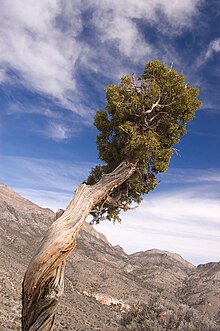Juniperus
| Juniperus | |
|---|---|
 |
|
| Juniperus osteosperma in Nevada, United States | |
| Scientific classification | |
| Kingdom: | Plantae |
| Division: | Pinophyta |
| Class: | Pinopsida |
| Order: | Pinales |
| Family: | Cupressaceae |
| Genus: |
Juniperus L. |
| Species | |
|
See text |
|
See text
Junipers are coniferous plants in the genus Juniperus /dʒuːˈnɪpərəs/ of the cypress family Cupressaceae. Depending on taxonomic viewpoint, between 50 and 67 species of juniper are widely distributed throughout the Northern Hemisphere, from the Arctic, south to tropical Africa, from Ziarat, Pakistan east to eastern Tibet in the Old World, and in the mountains of Central America. The highest-known Juniper forest occurs at an altitude of 16,000 feet (4,900 m) in south-eastern Tibet and the northern Himalayas, creating one of the highest tree-lines on earth.
Junipers vary in size and shape from tall trees, 20–40 m (66–131 ft) tall, to columnar or low spreading shrubs with long trailing branches. They are evergreen with needle-like and/or scale-like leaves. They can be either monoecious or dioecious. The female seed cones are very distinctive, with fleshy, fruit-like coalescing scales which fuse together to form a "berry"-like structure, 4–27 mm (0.16–1.06 in) long, with 1–12 unwinged, hard-shelled seeds. In some species these "berries" are red-brown or orange but in most they are blue; they are often aromatic and can be used as a spice. The seed maturation time varies between species from 6–18 months after pollination. The male cones are similar to those of other Cupressaceae, with 6–20 scales.
...
Wikipedia
